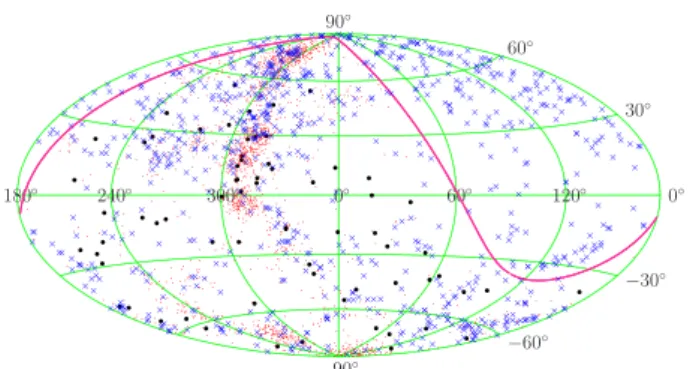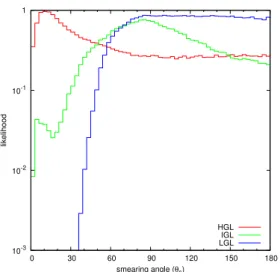Publications of the Korean Astronomical Society pISSN: 1225-1534
30: 549 ∼ 552, 2015 September eISSN: 2287-6936
2015. The Korean Astronomical Society. All rights reserved.c http://dx.doi.org/10.5303/PKAS.2015.30.2.549
STRONG INFLUENCE OF THE GALACTIC MAGNETIC FIELD ON THE PROPAGATION OF ULTRA-HIGH ENERGY COSMIC RAYS
Jihyun Kim1, Hang Bae Kim2, and Dongsu Ryu1
1Department of Physics, Ulsan National Institute of Science and Technology, Ulsan 689-798, Korea
2Department of Physics and The Research Institute of Natural Science, Hanyang University, Seoul 133-791, Korea E-mail: jihyunkim@unist.ac.kr, ryu@sirius.unist.ac.kr
(Received November 30, 2014; Reviced May 31, 2015; Aaccepted June 30, 2015)
ABSTRACT
The galactic magnetic field (GMF) and the intergalactic magnetic field (IGMF) affect the propagation of ultra-high energy cosmic rays (UHECRs) from the source to us. Here we examine the influences of the GMF/IGFM and the dependence of their sky distribution on galactic latitude, b. We analyze the correlation between the arrival direction (AD) of UHECRs observed by the Pierre Auger Observatory and the large-scale structure of the universe in regions of sky divided by b. Specifically, we compare the AD distribution of observed UHECRs to that of mock UHECRs generated from a source model constructed with active galactic nuclei. Our source model has the smearing angle as a free parameter that reflects the deflection angle of UHECRs from the source. The results show that larger smearing angles are required for the observed distribution of UHECRs in lower galactic latitude regions. We obtain, for instance, a 1σ credible interval for smearing angle of 0◦≤ θs≤ 72◦ at high galactic latitudes, 60◦ <|b| ≤ 90◦, and of 75◦ ≤ θs ≤ 180◦, −30◦ ≤ b ≤ 30◦, at low galactic latitudes, respectively. The results show that the influence of the GMF is stronger than that of the IGMF. In addition, we can estimate the strength of GMFs by these values; if we assume that UHECRs would have heavier nuclei, the estimated strengths of GMF are consistent with the observational value of a few µG. More data from the future experiments may make UHECR astronomy possible.
Key words: astroparticle physics — cosmic rays — magnetic fields — methods: statistical
1. INTRODUCTION
The ultra-high energy cosmic rays (UHECRs) are cos- mic rays with energies above 1019eV. The flux of UHE- CRs falls off dramatically at this extremely high energy due to the interactions of UHECRs with cosmic mi- crowave background (CMB) photons. The integrated flux at this energy is about one particle per square kilo- meter per year. Therefore, direct detection, such as via a balloon-borne detector, is no longer valid; indirect obser- vation using the atmosphere as a huge detector makes it possible to detect the primary particles of UHECRs. To increase the possibility of observation, gigantic ground experiments have been constructed over last 20 years.
Despite these efforts, we have still problems to solve in this area. The mass composition and the sources of UHECRs are the main properties of interest. A sum- mary of what we know from recent observational data of UHECRs follows. The mass composition of UHECRs is not conclusive. In chronological order, the High Res- olution Fly’s Eye experiment (HiRes) claimed that the primary particles seemed to be protons (Abbasi et al., 2009); however, the Pierre Auger Observatory (PAO) re- ported that the primaries would be heavy nuclei rather
http://pkas.kas.org
than lighter ones (Abraham et al., 2010). After that, the most recent results from the Telescope Array ex- periment (TA) (Tinyakov, 2014) show that the primary particles seem to be protons, again.
There have been many studies on the sources of UHE- CRs. Based on the Greisen-Zatsepin-Kuzmin (GZK) suppression (Greisen, 1966; Zatsepin & Kuzmin, 1966);
the steep suppression of the spectrum above the ener- gies∼ 4×1019eV caused by the interaction of UHECRs with CMB photons; we can restrict candidates for the sources; they would be located within rGZK∼ 100 Mpc.
There have been many attempts to identify the source of UHECRs using correlation tests with astrophysical objects or the matter distribution in the universe (Ab- basi et al., 2008; Abreu et al., 2010; Kim & Kim, 2013;
Kashti & Waxman, 2008; Takami et al., 2009); however, we have no conclusive correlation results yet.
When we study the sources of UHECRs, we should consider that the trajectories of UHECRs would be in- fluenced by the intervening magnetic fields while they propagate through the universe, because the primary UHECR is a charged particle. Once we pin down a spe- cific source candidate, we can estimate the properties of the intervening magnetic fields by investigating the deviation from the sources.
549

